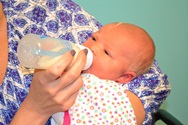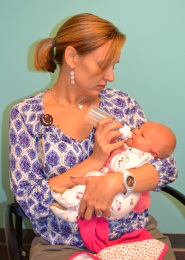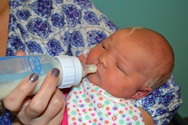Download a brochure with this information
Congratulations on the birth of your new child. A new baby brings out many feelings of joy, pride, awe and sometimes fears. When the baby has a medical condition, there is an additional feeling of uncertainty. Who will help our baby? What will our baby have to go through? How will we tell our family?
We understand the strength of your feelings and want to help. Feeding is one of the first and most basic needs that parents fulfill for their child. This pamphlet will give you some direction and information about feeding your infant born with a cleft lip, a cleft palate or both.
Feeding your baby with cleft palate or cleft lip
 The most immediate concern for a baby with cleft palate is good nutrition. The opening into the mouth from the nose causes a leak of air that prevents effective suction. If the infant has only a cleft lip, there should be no loss of suction and the infant can suck well from a bottle or a breast. When the gum and lip are cleft, the infant’s suction may be reduced and the baby might need a bottle with a freer flow rate, such as one of the vented bottles on the market, or a faster flow nipple. Some parents hold the two sides of the lip together without blocking the nostrils to restore suction immediately. The following are suggestions to help you decide how best to feed your baby.
The most immediate concern for a baby with cleft palate is good nutrition. The opening into the mouth from the nose causes a leak of air that prevents effective suction. If the infant has only a cleft lip, there should be no loss of suction and the infant can suck well from a bottle or a breast. When the gum and lip are cleft, the infant’s suction may be reduced and the baby might need a bottle with a freer flow rate, such as one of the vented bottles on the market, or a faster flow nipple. Some parents hold the two sides of the lip together without blocking the nostrils to restore suction immediately. The following are suggestions to help you decide how best to feed your baby.
Breastfeeding
- Breastfeeding an infant with a cleft lip but no cleft palate can be successful, but sometimes requires a changed feeding position so that mother’s breast tissue fills the gap in the lip or gum.
- Breastfeeding an infant with a cleft palate is quite challenging unless the infant’s cleft palate is very far in the back of the mouth and very small. Nursing at the breast is best limited to 10 minute sessions, and supplemental bottles will be needed if breastfeeding alone does not supply enough food for adequate satisfaction and growth.
- For most mothers of infants with cleft palate, breast pumping should begin in the birth hospital using a high quality electric breast pump and continue after each infant feeding.
- A lactation consultant is a breastfeeding mother’s best resource for correct positioning and pumping technique. Discuss your feeding plan with this specialist before discharge from the hospital.
Bottle Feeding
Having a cleft palate prevents an infant from making enough suction in the nipple to draw out formula or breast milk from a bottle. Specially designed bottle systems, nipples and flow valves aid int he comfort and effectiveness of feeding your newborn. Tips for bottle feeding:
- Small, frequent feedings are usual in the first weeks of life for an infant with a cleft palate. Give yourself and your baby time to learn how to eat, and
 expect longer than expected feeding times. Try to limit feedings to 30 minutes with an additional 10 minutes for burping and changing.
expect longer than expected feeding times. Try to limit feedings to 30 minutes with an additional 10 minutes for burping and changing. - Hold your baby in a semi-upright seated position, to limit the amount of liquid that enters the nasal passage. Keep your baby's head and shoulders in one hand and the bottle in your other hand. If you are more comfortable with the baby in the crook of your elbow, place a folded blanket or flat pillow under that elbow to hold the baby more upright. Some infants totally ignore drainage into the nose and you should not be alarmed to see a trickle come out. If there is a great amount of liquid in the nose, or if your baby spits up, tilt the baby forward. Your baby will swallow any extra milk in the back of the throat. The extra milk in the front of the mouth and nose will drain out by gravity. You may use a bulb suction to help, but the positioning is important to prevent any extra liquid from sliding to the back of the throat.
- Hold your infant so the head, neck and shoulders are in a straight line, or with the chin slightly tilted toward the chest.
- Tickle the baby’s lower lip or corner of the mouth with the nipple and place it over the tongue when the baby’s head turns toward the nipple and the mouth pops open. You may need to pull the lower jaw down gently to get the baby’s tongue down and out of the way.
 After placing the nipple in your baby's mouth, allow the baby to suck and breathe a few times before beginning any compression of either the Mead Johnson Cleft Palate Nurser bottle or the Haberman Feeder. Begin with gentle compression and slowly increase the pressure. Your infant's face should remain calm. For the Pigeon nipple, place the nipple in the mouth parallel to the floor so that it does not fill completely for the first few swallows. Once the infant has been comfortably breathing and feeding, you may lift the bottle so that the nipple fills more fully.
After placing the nipple in your baby's mouth, allow the baby to suck and breathe a few times before beginning any compression of either the Mead Johnson Cleft Palate Nurser bottle or the Haberman Feeder. Begin with gentle compression and slowly increase the pressure. Your infant's face should remain calm. For the Pigeon nipple, place the nipple in the mouth parallel to the floor so that it does not fill completely for the first few swallows. Once the infant has been comfortably breathing and feeding, you may lift the bottle so that the nipple fills more fully.- Remove the nipple from your baby’s mouth if you see any signs of distress, such as the head pulling back, no breath for 3-4 sucks, coughing or an alarmed look on your baby’s face. When calm behavior returns, begin again more slowly.
- There is little you can do to control the amount of air swallowed during feedings. Your baby will need to burp frequently, but don’t interrupt the feeding too much. For very young infants, all you will have to do to is straighten up the baby by pushing gently up at the back of the waist and lifting the front of the chest with the other hand.
Bottle Feeding Using the Dr. Brown's Bottle
Dr. Brown’s bottles come pre-assembled with a level 1 nipple. You will need to discard the level 1 nipple and replace it with a level 2 nipple to provide faster milk flow. You will also need a pigeon valve (a special one-way flow valve) to assist with the flow of milk. The pigeon valve is not sold separately; you must either order a pigeon bottle, which comes with two valves, or the pigeon nipple, which comes with one valve.
Click here to learn how to assemble the Dr. Brown's Level 2 nipple and pigeon valve
To order the Dr. Brown’s bottle and accessories: Dr. Brown’s bottles and Level 2 nipples may be purchased where infant bottles are sold. Pigeon bottles and nipples may be ordered by calling 888.766.8443.
Frequently Asked Questions...
How much should my baby eat?
Your goal should be 2 ounces of formula or breastmilk per pound of weight in each 24-hour period. For an average birth weight of 8 pounds, the goal for eating would be 16 ounces a day, divided into 6-8 bottles. The amount will increase when your baby starts gaining weight. Your baby will slowly increase each feeding by an ounce a week. The maximum amount per single feeding should range between 4-8 ounces.
What if the baby falls asleep during the feeding?
If your baby is a newborn or is 2 to 3 weeks early or more, sleepiness during feedings is common and the baby will need to be fed more frequently. Sleepiness may indicate that your baby is too warm, so try partially undressing the baby during feedings. The flow of milk may be too slow (see next question), so check the nipple and its flow.
What if the feeding takes longer than 30-40 minutes?
Lengthy feedings may indicate that the flow of milk is too slow for your newborn. For the Dr. Brown system with a pigeon valve, check to make sure you are using a Level 2 Dr. Brown nipple. For the Pigeon system, try loosening the nipple ring to increase flow.
What if the baby sleeps too long between feedings?
Although newborns sleep much of the time, do not let a newborn infant in the first weeks of life sleep longer than 5 hours unless he or she is eating more than needed for growth.










